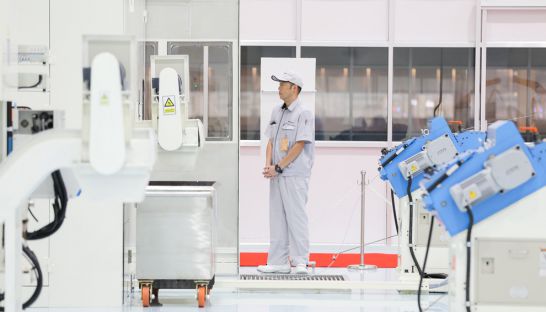Minebea scales up its production
Minebea scales up its production
Minebea, the largest private Japanese investor in Cambodia, unveiled a new production facility on the outskirts of Phnom Penh yesterday equipped with automated machinery capable of producing higher added-value engineering and electrical products.

The Japanese electronics giant held a ribbon-cutting ceremony for the new facility – its third within the Phnom Penh Special Economic Zone (Phnom Penh SEZ) – adding 60,000 square metres to its existing 40,000-square-metre footprint.
While the factory is not yet operational, and the installation of the new machinery has yet to begin, company representatives said the plant is expected to be up and running sometime next year following a gradual deployment of production lines.
“When this third plant finishes the completion of its production line, our total investment amount is expected to be well over $250 million,” said Yoshihisa Kainuma, president of Minebea.By 2019, that figure is expected to reach over $400 million, including fixed assets and other expenses, according to the company’s growth plan.
The ceremony also saw the signing of a brokered agreement between Minebea and state electricity provider Electricite du Cambodge (EdC) that will guarantee the factory access to cheaper energy. Kainuma cited the lower fees outlined in the deal as a major factor leading the company to continue to invest.
“Thanks to the higher quality and lower price of 115-kilovolt electricity supply, it has become possible for Cambodia to go from being a country of assembly only, using cheap labour, into an industrialised country,” he said.
Masashi Kono, chief representative of the Japan External Trade Organisation (JETRO) in Cambodia, said he hopes that Minebea’s expansion will be a signal to investors that Cambodia can scale up its manufacturing capabilities.
“At the moment, Minebea is importing all of its parts from Thailand and other countries and then assembling them here, but the third factory will have the latest capabilities and help manufacture almost all parts needed,” he said.
Prior to the third building, Minebea produced small-sized motors, LED backlighting for smartphones and street lighting systems. With the new building, the company will add fan motors, ball bearings and production of several machined parts.
Speaking to the Post in November, Minebea vice president Tetsu Shiozaki, said the reason for reinvesting in Cambodia and scaling up the level of production was tied to the company’s need to remain profitable in light of continuing minimum wage hikes.
“Just doing assembly processes alone is not enough reason to stay in Cambodia,” he said. “So we have to create higher valued products that then pay higher salaries.”
He acknowledged that the vocational training of workers provided by the company allowed it to become more competitive.













